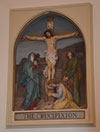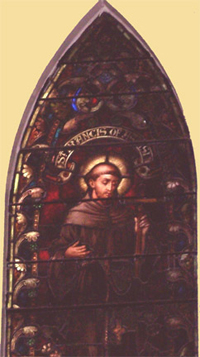Church Furnishings and Windows, Part 1

The large gilded crucifix which hangs from the dome of the apse was carved from olivewood in Italy. It was commissioned by Monsignor William J. Meredith for the church in the 1920s. The “halo” which encircles the intersection of the crossbars has a Latin inscription which translates: “Behold the wood of the Cross on which hung our salvation: Come let us worship.” The four symbols at the four ends of the cross, which appear also in the vision of Ezekiel and from the Book of Revelation, are traditional symbols of the four Evangelists: Matthew, Winged Man; Mark, Winged Lion; Luke, Winged Bull; John, Eagle. The crucifix was repainted and regilded in the renovation of 2023-2024.

On the side aisles of the church are the traditional fourteen Stations of the Cross (photo at right). The stations devotion is particularly popular during the season of Lent; participants follow the priest from one station to the next, recalling the Way of the Cross walked by Jesus to his crucifixion.

Until 2023 the organ loft contained a tracker pipe organ crafted by Carl Barckoff in 1910. It was restored, augmented, and rededicated in January, 1994, and, on June 26, 2022, played a large role in the first Mass celebrated by Father Dillon Bruce after his ordination. During the church renovation of 2023-2024, a decision was made that repairing it adequately would be too expensive an undertaking, and it was removed from the loft.

For what is assumed to be a temporary solution, a parishioner skilled in organ building constructed a small “chamber organ,” (see photo), a digital instrument described in more detail on this website.

The sixteen stained glass windows in the nave are of exceptional quality. They are among the finest church windows in the region. They include a triptych of small lancets over the altar, a circular window over the door, and six tall lancet windows along the two aisles. Aside from the rose window, the other windows date from the late nineteenth and early twentieth century. The windows appear to be from three or more different periods and perhaps from different shops. However, the windows are quite compatible in style and color and portray a consistent type of iconography.
Four or five windows are from Franz Meyer of Munich, Germany, and New York. Some of these bear the studio signature. They are distinguished by deep red and blue tones, a black/white/grey Gothic architectural border, and an angel at the top. The other windows appear to be of American origin. Among the other window groups, the three lancet windows at the altar end of the church have an architectural border of a Romanesque/Early Gothic type. The color tends to be warm, with a soft golden tone predominating. Two more windows which depict narrative figure groups seem to be of the same style. The St. Anthony window and the Christ in Gethsemane window are individual in style.
Most of the windows depict single-figure devotional images which fill most of the window space. Three are narrative and have two or more figures, the size of these compositions being compatible with other windows. The figures give the sense of a three-dimensional form and are naturalistic, a characteristic of much late nineteenth-century stained glass in American churches. Included in the predominantly architectural borders are some symbolic images. The colors are deep and rich. Landscape and architectural settings are suggested in the backgrounds. There does not appear to be a symbolic arrangement of the windows nor any sort of narrative sequence. Perhaps, as is often the case in church decoration, the donors were free to choose the subject of their window. For example, the donor of the St. Catherine of Alexandria window was named Catherine.
East End (Altar)

The three small lancet windows that occupy the upper vault of the apse are of approximately equal size. The colors are warm, and there is no architectural border because of their small size. St. Francis (photo at left) occupies the center lancet, flanked by two hearts. On the left, the Sacred Heart of Jesus is encircled by a crown of thorns and a dove above. The flaming heart suggests intense religious fervor. On the right, the Immaculate Heart of Mary is encircled by a chain of white flowers and a white lily above.

The apse also features murals of the four evangelists flanking the St. Francis, Sacred Heart, and Immaculate Heart windows. There was an effort to preserve the original works set in this space, but this proved impossible, and therefore in 2007 the parish engaged artist Jeff Stockberger to produce new representations of Matthew, Mark, Luke, and John (photo at left). These murals were installed in the previous location as they were completed.
West End (above choir loft)

The circular window (photo at left) contains a representation of the Ascension of Christ. Christ occupies the upper space, the eleven apostles the lower, curving upward in order to pleasingly fill the round space. Two men in white robes fill the space between the apostles and Christ, separating heavenly events from earthly according to the account of the event in Acts 1:9-11. The Christ figure is unusual in that He wears a red robe rather than the more traditional white. The colors are bright, similar to the lancets over the altar in tone. There is no architectural border. The rose window was part of the original structure and was a gift of John Geary.
top of page